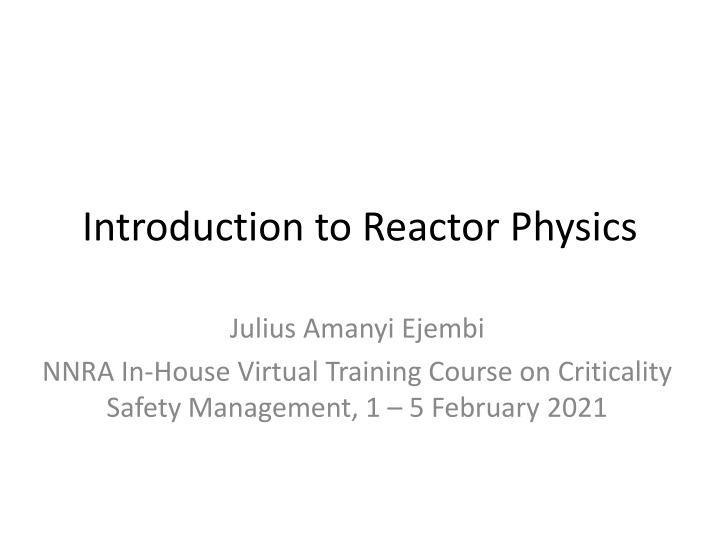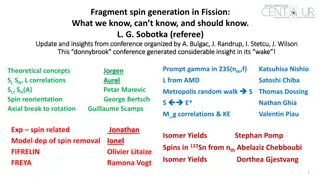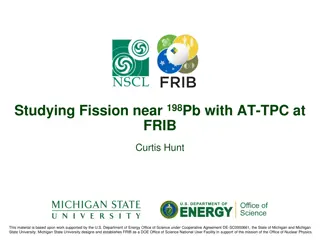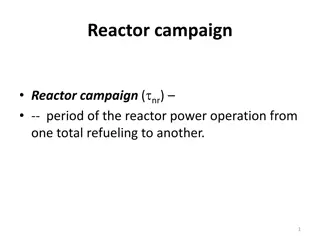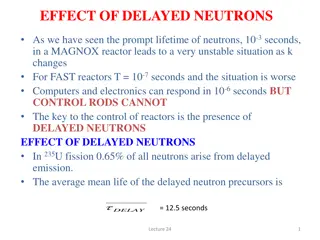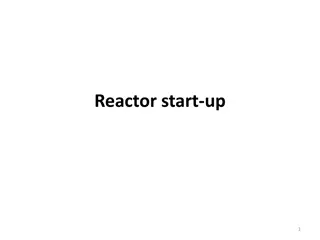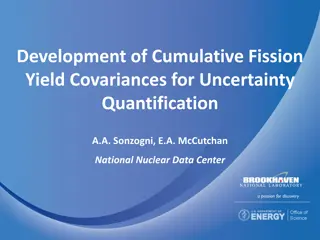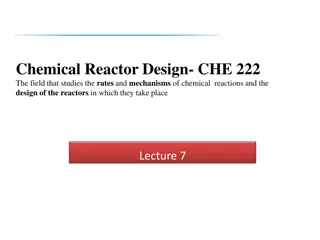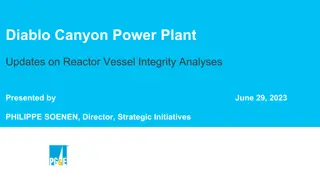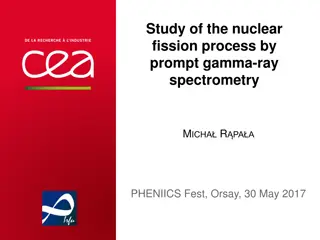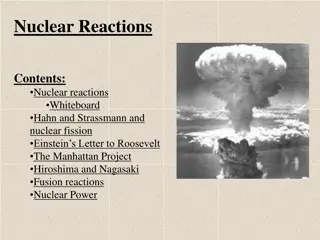Introduction to Reactor Physics and Nuclear Fission
Explore the fundamentals of reactor physics, neutron interaction, and nuclear fission in this virtual training course on criticality safety management. Delve into the history of nuclear fission, symbolisms for atoms, and the significance of critical reactors like Fermi's Chicago Pile. Gain insights into neutron multiplication, atomic structures, and key terminologies essential in nuclear reactions.
Uploaded on Sep 12, 2024 | 0 Views
Download Presentation

Please find below an Image/Link to download the presentation.
The content on the website is provided AS IS for your information and personal use only. It may not be sold, licensed, or shared on other websites without obtaining consent from the author.If you encounter any issues during the download, it is possible that the publisher has removed the file from their server.
You are allowed to download the files provided on this website for personal or commercial use, subject to the condition that they are used lawfully. All files are the property of their respective owners.
The content on the website is provided AS IS for your information and personal use only. It may not be sold, licensed, or shared on other websites without obtaining consent from the author.
E N D
Presentation Transcript
Introduction to Reactor Physics Julius Amanyi Ejembi NNRA In-House Virtual Training Course on Criticality Safety Management, 1 5 February 2021
Content Introduction Neutron Interaction Cross Section Neutron Multiplication in a Nuclear Reactor NNRA In-House Virtual Training Course on Criticality Safety Managment, 1 - 5 February 2021 9/12/2024 2
Content Introduction Neutron Interaction Cross Section Neutron Multiplication in a Nuclear Reactor NNRA In-House Virtual Training Course on Criticality Safety Managment, 1 - 5 February 2021 9/12/2024 3
Introduction Brief History of Nuclear Fission Symbol for an Atom or Nucleus Terminologies Nuclear Reaction, Mass Defect, Binding Energy NNRA In-House Virtual Training Course on Criticality Safety Managment, 1 - 5 February 2021 9/12/2024 4
Brief History of Nuclear Fission In 1934, Enrico Fermi bombarded uranium with neutrons and find the elements were found lighter than uranium. In 1938, Otto Hahn and Fritz Strassman fired neutron into uranium and found lighter elements such as barium in the leftover. Hahn and Strassman informed of this to Lise Meitner. She found total mass difference and applied Einstein s theory to show the lost mass changed to energy. Meitner named this phenomena Nuclear Fission . In 1942, Enrico Fermi achieved the first self-sustaining nuclear chain reaction using a graphite-moderated nuclear reactor known as Chicago Pile-1. NNRA In-House Virtual Training Course on Criticality Safety Managment, 1 - 5 February 2021 9/12/2024 5
Brief History of Nuclear Fission First Critical Reactor : Fermi s Chicago Pile constructed in a University Of Chicago squash court, December 1942 NNRA In-House Virtual Training Course on Criticality Safety Managment, 1 - 5 February 2021 9/12/2024 6
Symbol for an Atom or Nucleus X : atom or nucleus symbol , A : atomic mass, Z : atomic number and A = Z + N (Number of neutron) NNRA In-House Virtual Training Course on Criticality Safety Managment, 1 - 5 February 2021 9/12/2024 7
Some Terminologies Nucleon : particles that make of nucleus (proton, neutron). Nucleus : small and dense region consisting of nucleons at the center of an atom. Nuclei : plural form of Nucleus. Nuclide : an atom or nucleus identified by its nucleon numbers (A, Z). Isotopes : Nuclides with the same Z but with different N. - Beryllium isotopes : Be Be 4 4 , 7 9 10 4 , Be NNRA In-House Virtual Training Course on Criticality Safety Managment, 1 - 5 February 2021 9/12/2024 8
Nuclear Reaction, Mass Defect, Binding Energy Mass defect : Mass difference before and after nuclear reaction ) ( = mass = + + m m m Nm M p e n atom = Where m of proton, m = mass of neutron, p n = m mass of electron, m mass of atom e atom Binding energy : Energy required to bind nucleons, energy equivalent to mass defect. 2 ( { m mc E p B = = + + 2 ) } m Nm M c e n atom Nuclear Reaction : Interactions between the nucleus of an atom and a sub-atomic particle or the nucleus of another atom. NNRA In-House Virtual Training Course on Criticality Safety Managment, 1 - 5 February 2021 9/12/2024 9
Nuclear Reaction, Mass Defect, Binding Energy Binding energy in fission A heavy nuclide absorbs a neutron and splits into two fragments with the emission of 2 ~ 3 neutrons + + + 1 0 235 92 92 36 141 56 1 0 3 n U Kr Ba n NNRA In-House Virtual Training Course on Criticality Safety Managment, 1 - 5 February 2021 9/12/2024 10
Content Introduction Neutron Interaction Cross Section Neutron Multiplication in a Nuclear Reactor NNRA In-House Virtual Training Course on Criticality Safety Managment, 1 - 5 February 2021 9/12/2024 11
Neutron Interaction Neutron Production Neutron interaction NNRA In-House Virtual Training Course on Criticality Safety Managment, 1 - 5 February 2021 9/12/2024 12
Neutron Production Neutron Sources are not only necessary for experimental purposes, they play an important role in the start-up of nuclear reactors. Neutrons are easily produced by the interaction of alpha particles with light-element nuclei, such a beryllium, boron and lithium. + + 9 4 4 2 12 6 1 0 Be He C n ( 9 12 , ) Be n C NNRA In-House Virtual Training Course on Criticality Safety Managment, 1 - 5 February 2021 9/12/2024 13
Neutron Interaction As neutrons have not electric charge, they travel unaffected by the positive charge of the nucleus or by the negative charge of the electrons surrounding it. When penetrating matter, neutrons pass through the atoms electron cloud and interact directly with the nuclei. The reactions between the neutrons and nuclei are distributed into two main groups: Scattering Absorption NNRA In-House Virtual Training Course on Criticality Safety Managment, 1 - 5 February 2021 9/12/2024 14
Neutron Interaction It is usual to classify neutron interactions as follows: Elastic scattering Inelastic scattering Radiative capture Emission of charged particles Reactions producing neutron Nuclear fission NNRA In-House Virtual Training Course on Criticality Safety Managment, 1 - 5 February 2021 9/12/2024 15
Scattering The final result is an energy exchange between the two particles . The incident neutron remains free after the interaction NNRA In-House Virtual Training Course on Criticality Safety Managment, 1 - 5 February 2021 9/12/2024 16
Elastic Scattering A type of reaction in which the reaction products are the same as those initially present, namely the neutron and target nucleus. Symbolized by the expression (n,n). This reaction is an elastic collision between the neutron and the nucleus. Since the nucleus is almost always in its ground state and remains this way after the collision, there is no -ray emission is involved. Kinetic energy is conserved NNRA In-House Virtual Training Course on Criticality Safety Managment, 1 - 5 February 2021 9/12/2024 17
Inelastic Scattering This occurs when a nucleus capture a neutron that it is later reemitted (being either the same capture neutron or another one) while the nucleus is left in an excited state. When it finally returns to its ground state, the nucleus emits radiation. This reaction is expressed by (n,n ). Kinetic energy is not conserved NNRA In-House Virtual Training Course on Criticality Safety Managment, 1 - 5 February 2021 9/12/2024 18
Absorption The neutron is captured by the nucleus, forming new particles. From the standpoint of nuclear reactors, the most important absorption reactions are radiative capture and fission. NNRA In-House Virtual Training Course on Criticality Safety Managment, 1 - 5 February 2021 9/12/2024 19
(n,2n) Reaction For very high energies , above 10 MeV, the incident neutron energy is sufficient to cause the emission of more than one particle by the target nucleus. Reactions of the following types can take place: (n, 2n) (n, np) (n, 3n), etc Because of the coulomb barrier, the emission of neutrons is more likely to occur than the emission of charged particles. (n, 2n) type reactions have a threshold energy of 10 MeV. Above this threshold, cross section increases with energy, reaching a peak near 20 MeV, and then decreases with increasing energy of the incident neutron. NNRA In-House Virtual Training Course on Criticality Safety Managment, 1 - 5 February 2021 9/12/2024 20
Radiative Capture In this reaction, the neutron is absorbed by the target nucleus, forming a new isotope heavier than the original nucleus, and one or more -rays are emitted. Those rays are called capture -rays and the reaction is represented by (n, ). NNRA In-House Virtual Training Course on Criticality Safety Managment, 1 - 5 February 2021 9/12/2024 21
Charged Particles Emission The emission of charged particles is the process that occurs when the reaction induced by a neutron results in a nucleus different from the initial one and an electrically charged particle (proton, particle or deuteron) is emitted. NNRA In-House Virtual Training Course on Criticality Safety Managment, 1 - 5 February 2021 9/12/2024 22
Neutron-Producing Reactions This are reactions which emit a neutron after the capture of another particle, or those in which a neutron is captured and two or more neutrons are emitted. They are symbolized by (n, 2n), (n, 3n), etc. Two important examples of these types of reactions are: n Be 4 ) , ( 9 8 4 Be ( 9 12 , ) Be n C This are used as neutron sources in nuclear reactors. In the first reaction, Sb is the provider of gamma rays. In the second reaction, Am and Po are the suppliers of alpha particles. NNRA In-House Virtual Training Course on Criticality Safety Managment, 1 - 5 February 2021 9/12/2024 23
Fission Nuclear fission occurs when a heavy nucleus absorbs a neutron and, splits into two lighter nuclei, called fragments or fission products, while simultaneously emitting two or more neutrons. NNRA In-House Virtual Training Course on Criticality Safety Managment, 1 - 5 February 2021 9/12/2024 24
Summary NNRA In-House Virtual Training Course on Criticality Safety Managment, 1 - 5 February 2021 9/12/2024 25
Content Introduction Neutron Interaction Cross Section Neutron Multiplication in a Nuclear Reactor NNRA In-House Virtual Training Course on Criticality Safety Managment, 1 - 5 February 2021 9/12/2024 26
Cross Section Microscopic Cross Section Macroscopic Cross Section Mean Free Path NNRA In-House Virtual Training Course on Criticality Safety Managment, 1 - 5 February 2021 9/12/2024 27
Cross Section 1 Cross sections measure the probability of occurrence of a particular nuclear reaction. There is no expression that allow us to calculate theoretical cross sections. These are experimentally measured. Let s imagine the following experience: a parallel beam of monoenergetic neutrons (all neutrons have the same kinetic energy and parallel paths) perpendicularly striking on a very thin plate. This plate has a thickness of x, and is made of a material (e.g. iron) whose cross section needs measurement. NNRA In-House Virtual Training Course on Criticality Safety Managment, 1 - 5 February 2021 9/12/2024 28
Cross Section 2 n is the incident neutron beam density (number of neutrons per cm3) and v is its speed. The beam intensity I (number of neutron per cm2 per second) will be: n I = v NNRA In-House Virtual Training Course on Criticality Safety Managment, 1 - 5 February 2021 9/12/2024 29
Microscopic Cross Section 1 Among the neutron that strike the plate some will collide with the nuclei and the rest will cross the plate without suffering any collision. Experimentally it is verified that the number of collisions is proportional to the beam intensity I, to the atomic density N (number of nuclei per cm3) of the target, to the area and to the plate s thickness x, so Number of collision per second in the target Where the proportionality constant is called microscopic cross section = I N A x NNRA In-House Virtual Training Course on Criticality Safety Managment, 1 - 5 February 2021 9/12/2024 30
Microscopic Cross Section 2 Note that N*A* x is the total number of nuclei of the plate. Thus the number of collision per second is .I, and so then is the number of collisions per second per nucleus per intensity unit of the beam. Another interpretation, in terms of probability is: a of y propabilit Collision = neutron wi nucleus a th Number of collisions per second in the plate = [Total number of second] per plate on the neutron incident [Total number of nuclei] I N A x I = = = ( ) ( ) A I N A x A I A As the probability is dimensionless, it can be concluded that is the effective area given by the nucleus to an incident neutron for a nuclear reaction. The unit used for cross section is the barn (b), being equal to 10-24 cm2 9/12/2024 Criticality Safety Managment, 1 - 5 February 2021 NNRA In-House Virtual Training Course on 31
Microscopic Cross Section 3 When the interaction of a neutron with a nucleus occurs, the products of the reaction are not always the same. Thus the cross section is defined for each type of reaction: f = Fission cross section r = Radiative capture cross section The total cross section or cross section for all possible interactions is the sum of the cross section for each type of interaction: t = s + i + f . NNRA In-House Virtual Training Course on Criticality Safety Managment, 1 - 5 February 2021 9/12/2024 32
Macroscopic Cross Section Remember that total Number of collision per second in the target The number of collisions per unit volume = = I N A x x = = t F t x Where F is the collision density The product section = total macroscopic cross = t t NNRA In-House Virtual Training Course on Criticality Safety Managment, 1 - 5 February 2021 9/12/2024 33
Mean Free Path The mean free path ( ) is the average distance traveled by a neutron between two successive collisions Since Therefore Where t = = I n v v 1 = = = v . n v n n t t t NNRA In-House Virtual Training Course on Criticality Safety Managment, 1 - 5 February 2021 9/12/2024 34
Content Introduction Neutron Interaction Cross Section Neutron Multiplication in a Nuclear Reactor NNRA In-House Virtual Training Course on Criticality Safety Managment, 1 - 5 February 2021 9/12/2024 35
Neutron Multiplication in a Nuclear Reactor Fission Chain Reaction Multiplication Factor Control of Nuclear Reactor Neutron Multiplication NNRA In-House Virtual Training Course on Criticality Safety Managment, 1 - 5 February 2021 9/12/2024 36
Fission Chain Reaction 1 Two Phenomena of great importance occur in nuclear fission: Release of tremendous amount of energy Production of new neutrons The combination of these two makes the construction of a nuclear reactor possible. A nuclear reactor is a device in which the fission chain reaction mechanism can be self maintained, controlled, and providing a continuous release of energy at the same time. NNRA In-House Virtual Training Course on Criticality Safety Managment, 1 - 5 February 2021 9/12/2024 37
Fission Chain Reaction 2 In the chain reaction depicted below, neutrons emitted by the nuclei that underwent fission, induce fission in other fissile or fissionable nuclei. The neutrons from these new fissions induce more fissions in other fissile or fissionable nuclei and so on. NNRA In-House Virtual Training Course on Criticality Safety Managment, 1 - 5 February 2021 9/12/2024 38
Multiplication Factor The chain reaction is represented by the multiplication factor k, defined as the ratio between the number of fissions (or neutrons) of a given generation and the number of fissions (or neutrons) of the previous generation. number of fission neutrons) (or given a of generation k = number of fissions neutrons) (or of generation last the Depending on the value of k, three different situations can show up. NNRA In-House Virtual Training Course on Criticality Safety Managment, 1 - 5 February 2021 9/12/2024 39
Supercritical System If k is greater than 1, the number of fissions grows from generation to generation. In this case, the chain reaction is divergent because the number of fissions grows over time and so does the amount of energy released. NNRA In-House Virtual Training Course on Criticality Safety Managment, 1 - 5 February 2021 9/12/2024 40
Subcritical System If k is less than 1, the number of fissions decrease with time and the chain reaction is convergent, tending to extinction. NNRA In-House Virtual Training Course on Criticality Safety Managment, 1 - 5 February 2021 9/12/2024 41
Control of Nuclear Reactors 1 NNRA In-House Virtual Training Course on Criticality Safety Managment, 1 - 5 February 2021 9/12/2024 42
Control of Nuclear Reactors 2 NNRA In-House Virtual Training Course on Criticality Safety Managment, 1 - 5 February 2021 9/12/2024 43
Control of Nuclear Reactors 3 In order to adjust k to the desired value, the neutron production rate has to be adjusted with the rate of disappearance. Neutron from the reactor may disappear in two ways: Escaping from the reactor through its surface and Being absorbed by nuclear reactions and radiative capture reactions in the materials that the reactor is made off. NNRA In-House Virtual Training Course on Criticality Safety Managment, 1 - 5 February 2021 9/12/2024 44
Control of Nuclear Reactors 4 When the sum of the neutron capture rate and the neutron leakage or escape rate is equal to the rate at which they are produced, the reactor will be critical. If the production rate is higher or lower than the rates of capture plus leakage, the reactor is supercritical or subcritical respectively. NNRA In-House Virtual Training Course on Criticality Safety Managment, 1 - 5 February 2021 9/12/2024 45
Control of Nuclear Reactors 5 Two or three neutrons are emitted in fission reaction and only one is necessary to maintain the fission chain reaction. It may appear that once initiated, fission reaction a given mass of fissile material will continue. However, not all neutrons are used to maintain the chain reaction. Some of them are lost by nuclear reactions different from fission, mainly radiative capture while others may escape from the system. NNRA In-House Virtual Training Course on Criticality Safety Managment, 1 - 5 February 2021 9/12/2024 46
Critical Mass The fraction of neutrons that escape from the geometric boundaries of the system can be reduced by appropriately increasing the size or mass of the fissile material. The minimum amount of such material, capable of sustaining fission chain reaction, once started with an external source of neutron is called critical mass. NNRA In-House Virtual Training Course on Criticality Safety Managment, 1 - 5 February 2021 9/12/2024 47
Neutron Multiplication 1 Consider the calculation of the multiplication factor for a certain amount of uranium fuel in a homogeneous system. The heat release is evacuated using a coolant. The structural materials are homogenous and the composition is uniform. Without considering the distinction between prompt and delayed neutrons. Let us now consider the occurrence probability of different potential neutron interactions in the same fission generation. NNRA In-House Virtual Training Course on Criticality Safety Managment, 1 - 5 February 2021 9/12/2024 48
Neutron Multiplication 2 The neutron can be absorbed by the system or escape from it. If absorbed, this can be in the fuel or any other reactor material. If absorbed by the fuel, it may undergo radiative capture or fission. NNRA In-House Virtual Training Course on Criticality Safety Managment, 1 - 5 February 2021 9/12/2024 49
Neutron Multiplication 3 Defining the probabilities: PNL= Probability that the neutron remains absorbed in the system PAF= Probability that it is actually absorbed in the fuel PF = Probability that it induces a fission reaction. NNRA In-House Virtual Training Course on Criticality Safety Managment, 1 - 5 February 2021 9/12/2024 50
